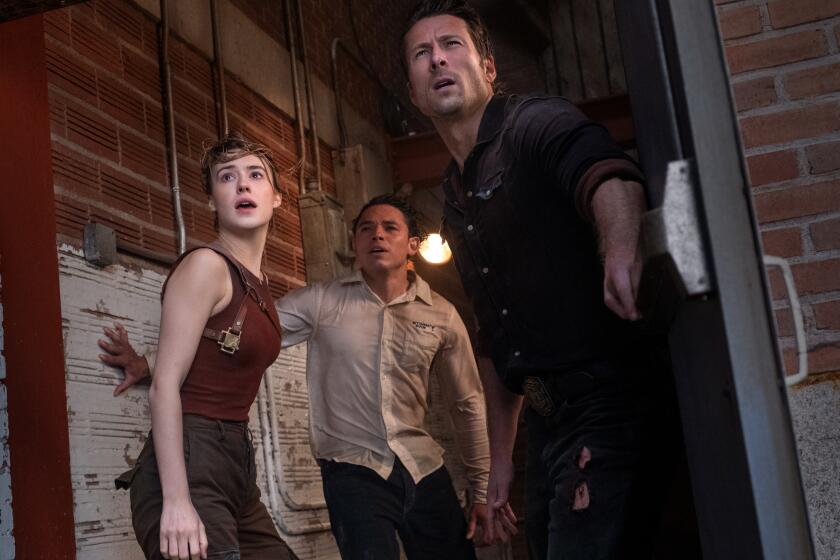Expanding the universe
Shane Acker’s dark fantasy film “9” is not your average animated movie. In the PG-13 release, opening Wednesday, the world is a cruel and frightening place that looks a little like war-torn 1940s Europe as rendered by German director Fritz Lang. Its sole inhabitants are nine rag-doll creatures who have numbers instead of names and who are repeatedly victimized by vicious, robotic monstrosities.
Expecting cheery musical numbers and winking pop-culture references? Think again.
But the movie was never intended to be just for (older) kids. Acker adapted “9” from his award-winning 2005 short of the same theme, expanding the landscape and the number of characters but sticking close to the original story line.
Despite the overt bleakness, there are moments of levity and charm, even hope. The director, a transplant from the Midwest, points out that the tiny burlap beings at the center of the action see their ravaged home as a place of infinite possibility.
“For them, it’s just a world of raw materials and they have a very positive experience,” said Acker over a late-morning coffee in Culver City recently. “They’re very creative and they’re making contraptions and things to make a better life for themselves.”
The film begins with the title character (voiced by Elijah Wood) waking up alone inside a makeshift attic laboratory. He ventures into the outside world and soon meets others of his kind hiding in an old clock tower, away from the murderous machines. Rather than live in fear, 9 decides that they must confront the threat and he persuades several of his newfound comrades, including the timid 5 (John C. Reilly), to join him in his dangerous mission.
The ideas in “9” date to when Acker was a graduate student in architecture at UCLA and opted to take some animation classes on the side. He created the small numbered characters for a storyboard class and used two of them, 9 and 5, in his short, which played at the 2005 Sundance Film Festival and won the gold medal at the Student Academy Awards that same year. In 2006, it was nominated for an Oscar in the animated short category.
Acker didn’t win the prize -- though “Eric Bana did hold the bathroom door open for me,” he said -- but the acclaim “9” garnered brought him to the attention of independent producer Jim Lemley. He, in turn, recruited the movie’s two big-name producers, Tim Burton and Timur Bekmambetov.
The veteran filmmakers responsible for such spectacle-heavy fare as “Charlie and the Chocolate Factory” and “Wanted,” respectively, understood the challenges that lay ahead for Acker and offered to share their insight. Their advice proved critical during the three years it took to transform the short into a full-length feature on a relatively modest $30-million budget.
In Burton’s case, especially, it’s not a stretch to see why he might have fallen for the look and feel of “9”: During an interview at San Diego’s Comic-Con International this summer, he said he was struck by how similar the young director’s visual aesthetic was to his own, though it still felt original.
“It was different enough from mine but I felt a connection to it,” he said. “Having gone through this process myself trying to get films made . . . I thought I could help him with that, I thought I could help protect him from the forces of evil and let him focus on making his film.”
Although it’s unusual to have established directors shepherding a project from a less experienced filmmaker, when it does happen, the results can be impressive. Producer J.J. Abrams helped Matt Reeves usher the monster movie into the YouTube era with 2008’s “Cloverfield,” and more recently Peter Jackson worked behind the scenes to ensure that Neill Blomkamp could make his science fiction thriller “District 9” the way he felt it should be made.
“They had the kind of critical distance that I didn’t, they could ask the big questions and see it with fresh eyes,” Acker said of his mentors.
Big-name producers aside, it was Acker’s vision and the way he and screenwriter Pamela Pettler (“Corpse Bride”) chose to tell the story that attracted Wood to the role. The narrative unfolds like a mystery, with the characters only gradually discovering their origins and how the world came to be in such a derelict state through old newsreel footage and propaganda posters.
“9, he’s the one asking all the questions,” Wood said. “He almost represents the audience because they’re in the dark and he’s in the dark and he’s trying to get at what he is and what’s been going on.”
“We wanted there to be a mysterious element to it,” Acker said. “We wanted the audience to really pay attention and lean in and participate.” Once they do that, he says, “you’ve engaged them on a level that’s meaningful in some way.”
Should “9” connect with moviegoers, Acker has plenty of ideas for other stories set in his alternate world and is prepared to move forward on a sequel. He’s also been developing another animated project based on a graphic novel, though he says it’s too early to say more.
As for whether his cautionary tale about the perils of technology will be too intense for younger moviegoers, Acker, like 9, remains optimistic. For the last decade or so, the chieftains at Pixar have been extolling the virtues of animation as a vehicle for sophisticated storytelling -- one appropriate for, but not limited to, the elementary school set -- and Acker hopes that “9” will continue to advance that argument.
“I think that kids have been sophisticated all along,” said Acker, who’s expecting his first child with his wife on Thursday. “It’s just that we as adults forgot that and we just made everything so soft and took all the edges off of everything, but that’s not the reality of the world we live in. If you look at the old Walt Disney films like ‘Snow White and the Seven Dwarfs’ and ‘Bambi,’ films that we all saw as children that we love, they’re dealing with death, but they’re really engaging.”
--
More to Read
Only good movies
Get the Indie Focus newsletter, Mark Olsen's weekly guide to the world of cinema.
You may occasionally receive promotional content from the Los Angeles Times.











